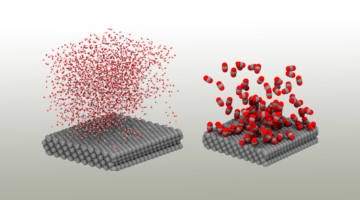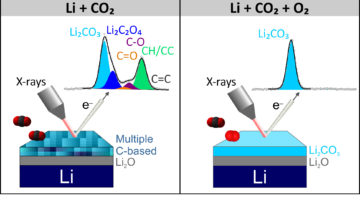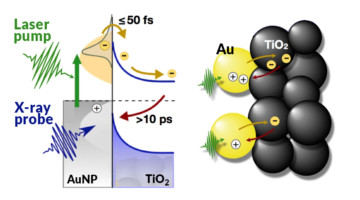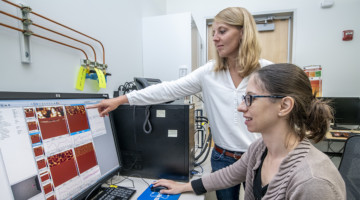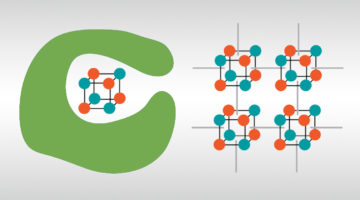A Berkeley Lab research team developed a new artificial photosynthesis device component that exhibits remarkable stability and longevity as it selectively converts sunlight and carbon dioxide into two promising sources of renewable fuels—ethylene and hydrogen. Read more »
Exquisitely Selective CO2 Reduction on Silver
Researchers electrochemically reduced CO2 to CO with nearly perfect selectivity over other products by adding an organic compound to the surface of a silver electrode. With theoretical analyses and ALS data, the work revealed the key role of the microenvironment in promoting the conversion of CO2, a greenhouse gas, into useful products. Read more »![]()
![]()
New Insights into Lithium-Metal Surface Reactions for Next-Generation Batteries
In this work, researchers studied how CO2 gas modifies the chemical composition of lithium-metal surfaces. A better understanding of the interactions between lithium and surrounding gases will help design stabilization strategies and move from lithium-ion technology to high-energy-density technologies based on lithium metal. Read more »
Coming Down the Pike: Long-Haul Trucks Powered by Hydrogen Fuel Cells
DOE has announced several major investments to take hydrogen fuel cells to the next level, and Berkeley Lab is set to play a leading role. Ten DOE national labs have been selected to participate in two new consortia and a third continuing one to improve the durability, lifetime, and efficiency of fuel cells. Read more »
Scientists Capture Candid Snapshots of Electrons Harvesting Light at the Atomic Scale
A team of scientists has gained important new insight into electrons’ role in the harvesting of light in gold/TiO2 nanoparticle photoelectrochemical (PEC) systems. The scientists say that their study can help researchers develop more efficient material combinations for the design of high-performance solar fuels devices. Read more »
A Probe of Light-Harvesting Efficiency at the Nanoscale
Using time-resolved experiments at the ALS, researchers found a way to count electrons moving back and forth across a model interface for photoelectrochemical cells. The findings provide real-time, nanoscale insight into the efficiency of nanomaterial catalysts that help turn sunlight and water into fuel through artificial photosynthesis. Read more »![]()
![]()
A Closer Look at Water-Splitting’s Solar Fuel Potential
Although bismuth vanadate (BiVO4) is a theoretically attractive material for electrodes in photoelectric chemical cells (PECs) used for artificial photosynthesis, it hasn’t lived up to its potential. Researchers used a multimodal approach to gain new insight into what might be happening at the nanoscale to hold BiVO4 back. Read more »
Probing the Evolution of Photovoltaic Films during the Spin-Coating Process
A new, in-beamline spin-coating platform enabled researchers to probe the structure of a promising photovoltaic material in the crucial early stages of processing. The results demonstrate the power of multimodal in situ techniques as promising tools for optimizing synthesis parameters and, thus, device performance. Read more »
Molecular Framework Imparts Stability to Reactive Catalyst
Researchers have shown that a rigid metal–organic framework (MOF) can be used to stabilize core regions of a reactive catalyst that has potential for use in artificial photosynthesis. The framework immobilizes and preserves key reactive intermediates and affords a clearer view of how the catalyst’s structure correlates with function. Read more »
Here Comes the Sun: A New Framework for Artificial Photosynthesis
Scientists have long sought to mimic the process by which plants make their own fuel using sunlight, carbon dioxide, and water through artificial photosynthesis devices, but exactly how catalysts work to generate renewable fuel remains a mystery. Now, a study has uncovered new insight into how to better control cobalt oxide, one of the most promising catalysts for artificial photosynthesis. Read more »

